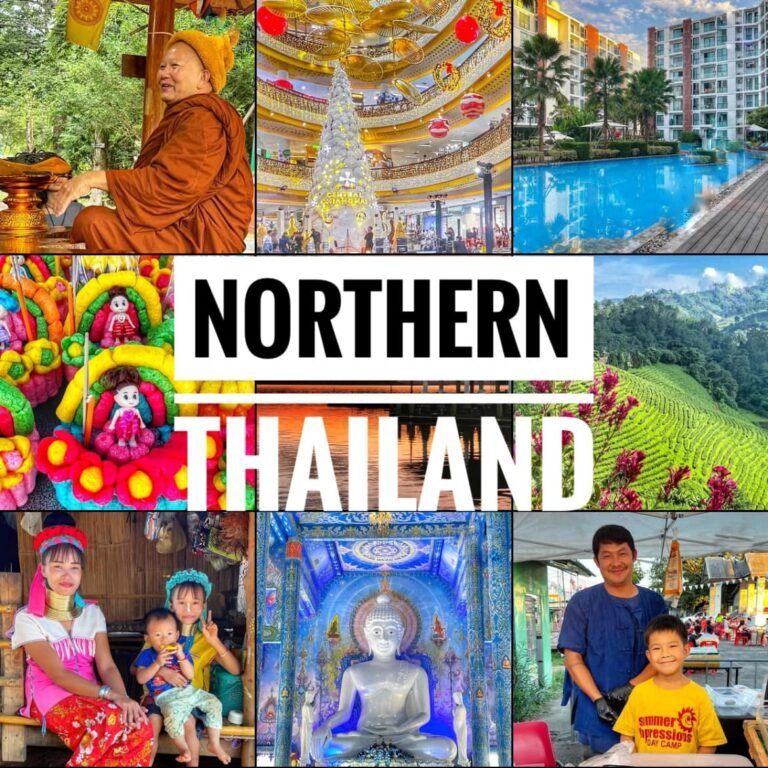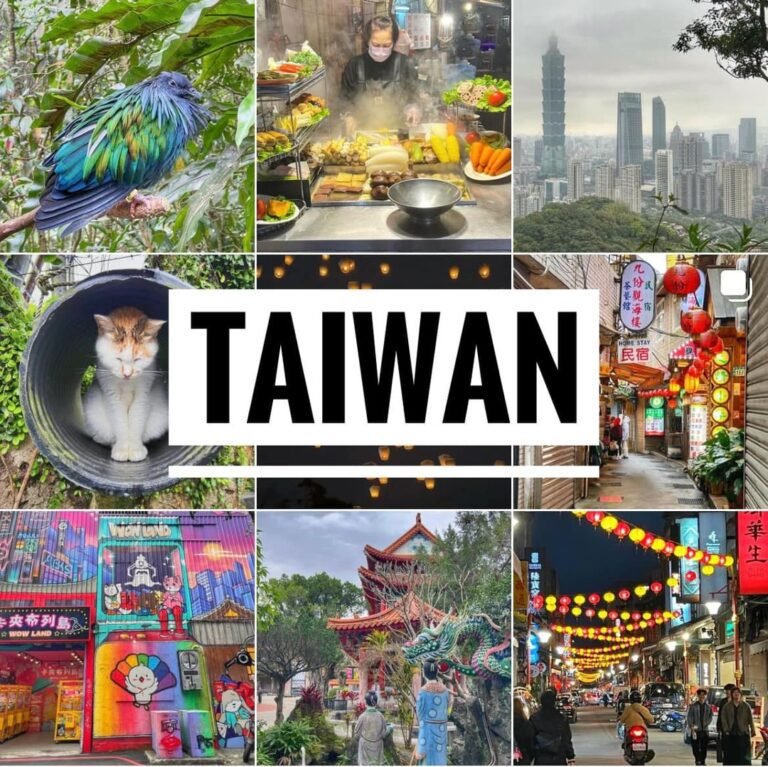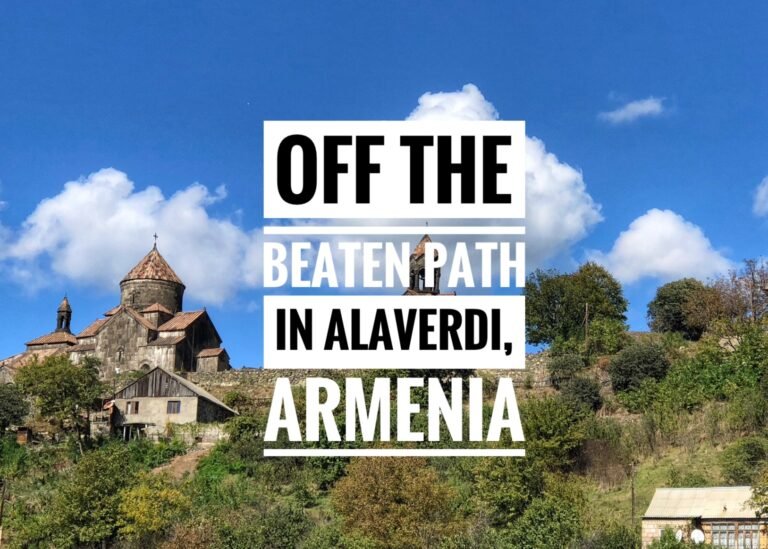
Kampot is a coastal city on the Preaek Tuek Chhu River in southern Cambodia. We’d had our eyes on heading there for several weeks so it felt good to finally get the opportunity to hop on a totally empty, A/C blasted, $8/ticket mini bus for the three-hour jaunt out of Phnom Penh. Although the area is most widely known for its pepper plantations and salt production, there are a few lingering reminders of the French colonial times with a few characteristic buildings scattered around the historic center of Kampot.
For us, were desperate to shed our urban Phnom Penh surroundings and jump into some nature. So, we settled into the Bamboo Bungalows, situated conveniently at the rivers edge… a surprisingly lovely and highly swimmable river. Scooter rentals were just $5 for the day in Kampot, perfectly priced for an outing to putter along down the coast an hour to the crab & fishing village of Kep, where we gorged on fresh caught crab and shrimp dishes.
Also, the very walkable and active town of Kampot beckoned us to stroll across the river on a fantastically atmospheric rusting bridged train trestle, made our eyes bulge at the sight of the world’s biggest Durian traffic circle, and do a double take when encountering deadly Mandy-eating ostriches

‘Tis the season. Durian season! On our walk from the bus station we encountered the first reminders of the in-season smells of Kampot…the potently odorific fruit is often banned in public places. The (practically deadly) spiky melon ball is for sale in the back of pick-up trucks, often at premium prices. Of course, this is all Mandy’s opinion. Greg pretends to not mind them just to annoy her, and also to improve his personal nerd quest to add to his world fruit cred.
For the record, durian is not cheap. A pre-cut kilo of it at the grocery store costs about $8-$12 and a whole one around $15 at a roadside stand! But, if you buy it this way, then you have the challenge of getting into it and only being able to actually eat about 30% of this massive fruit.
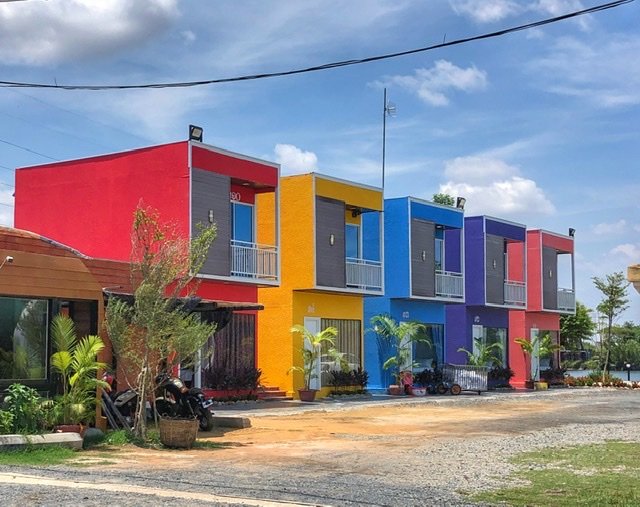
Kampot is chocked full of high-quality budget accommodations. This colorful one, on the walk to ours caught our eye, as well as one called “The Playground” which offered large, colorful playgrounds and whimsical trees for the kids to climb, while the parents get to play in the rooftop bar.

Our accommodation, the Bamboo Bungalows, were a little more quaint. Located right on the river, which you could jump off in from the dock on your room, it also offered a restaurant with delicious food and $1 beers, which is an acceptable markup for a mediocre lager.
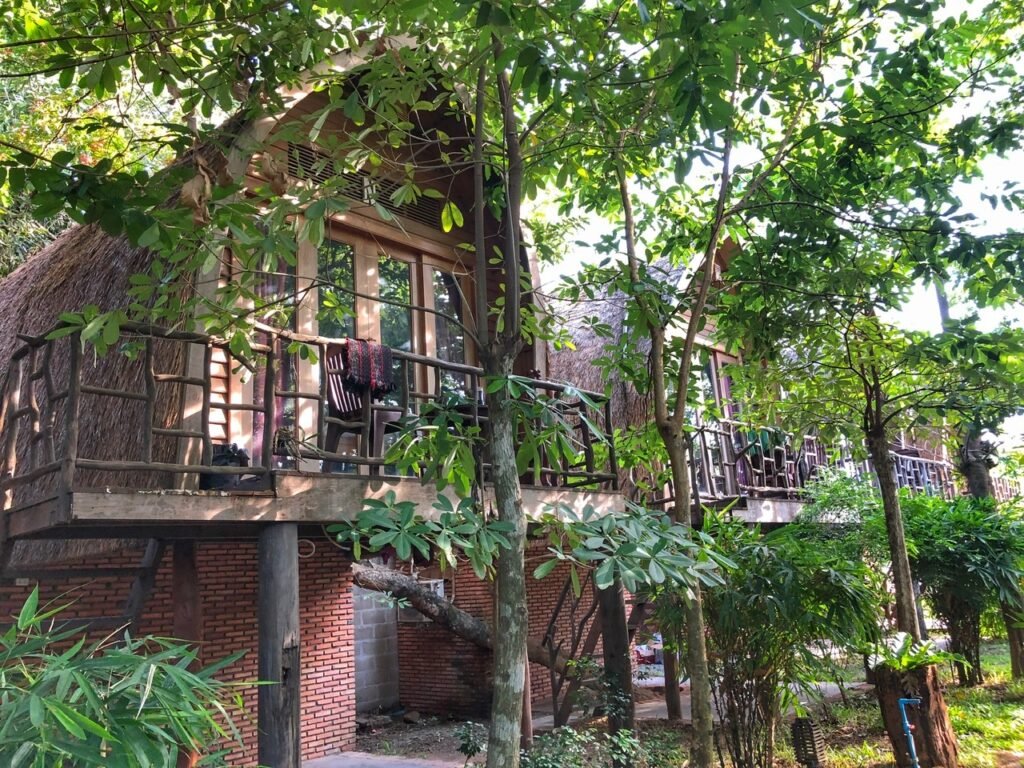
Truth be told, of course, although we were tempted we did not sleep in the rooms on the river because they were $30/night and we were already paying double rent back in Phnom Penh for our apartment . Instead, we paid $13 for a garden view which ended up working out just fine.
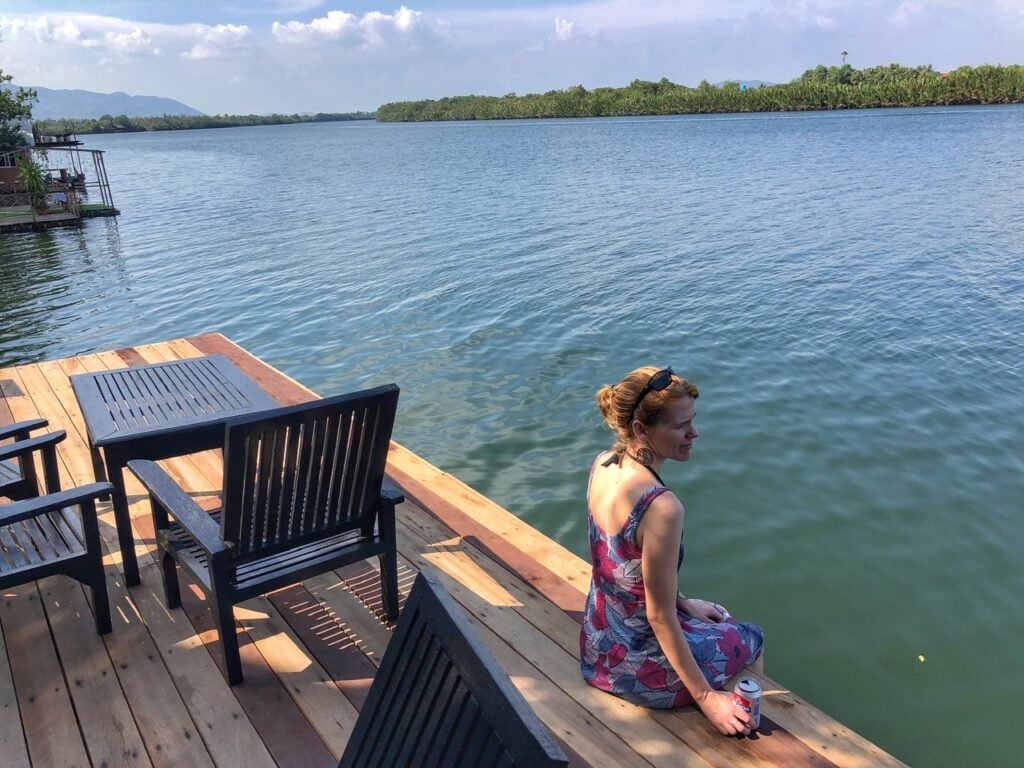
Speaking of docks and beers….
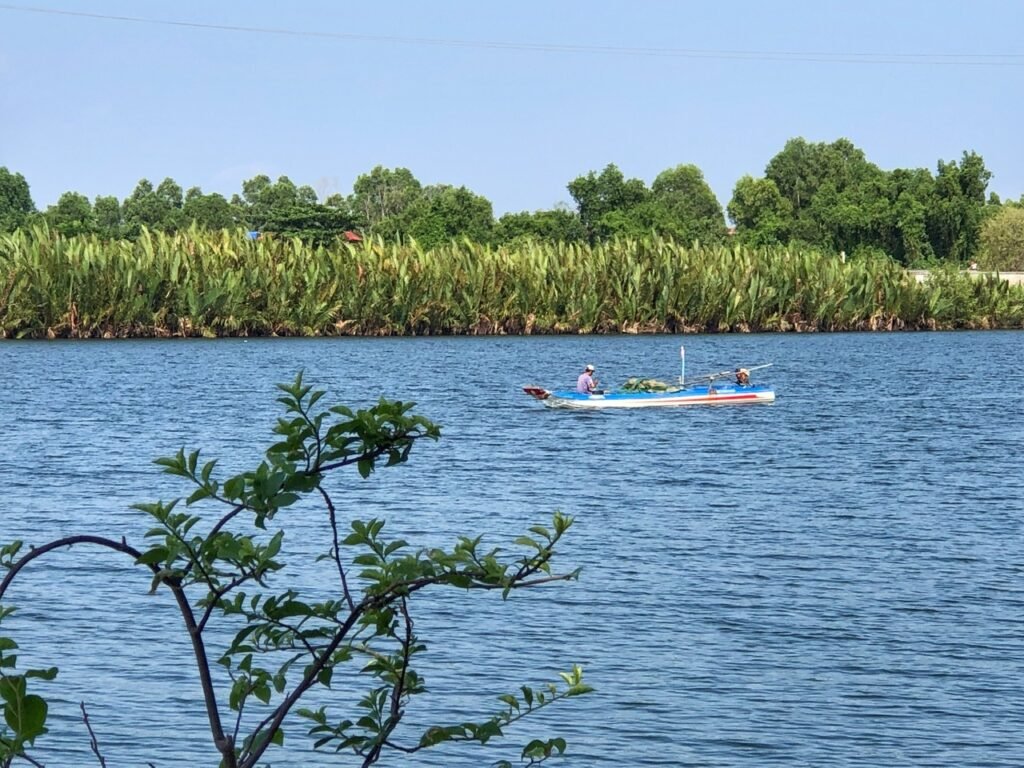
Watching the fishing boats collect their catch. We loved the mangrove tree backdrop from here.
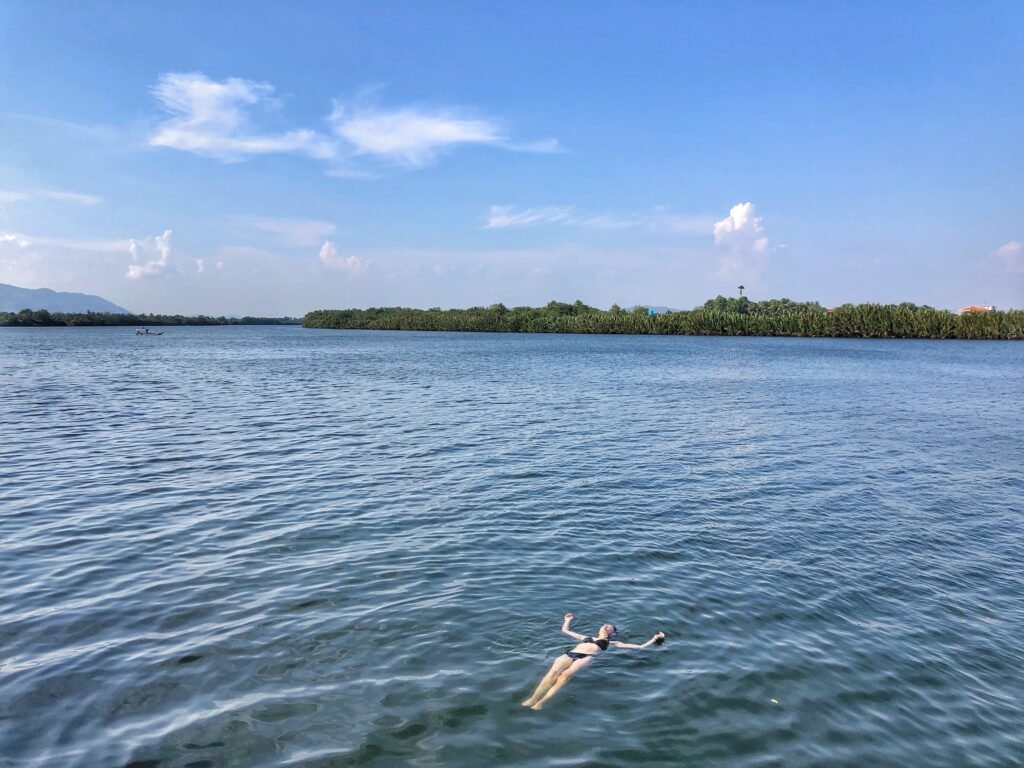
And floating in the river, which is actually a salt water estuary. A fact that really helps to keep the bugs down! The temperatures are still typically hovering around 100F/38C, making this swimming area a definite added value. And the water was warm!
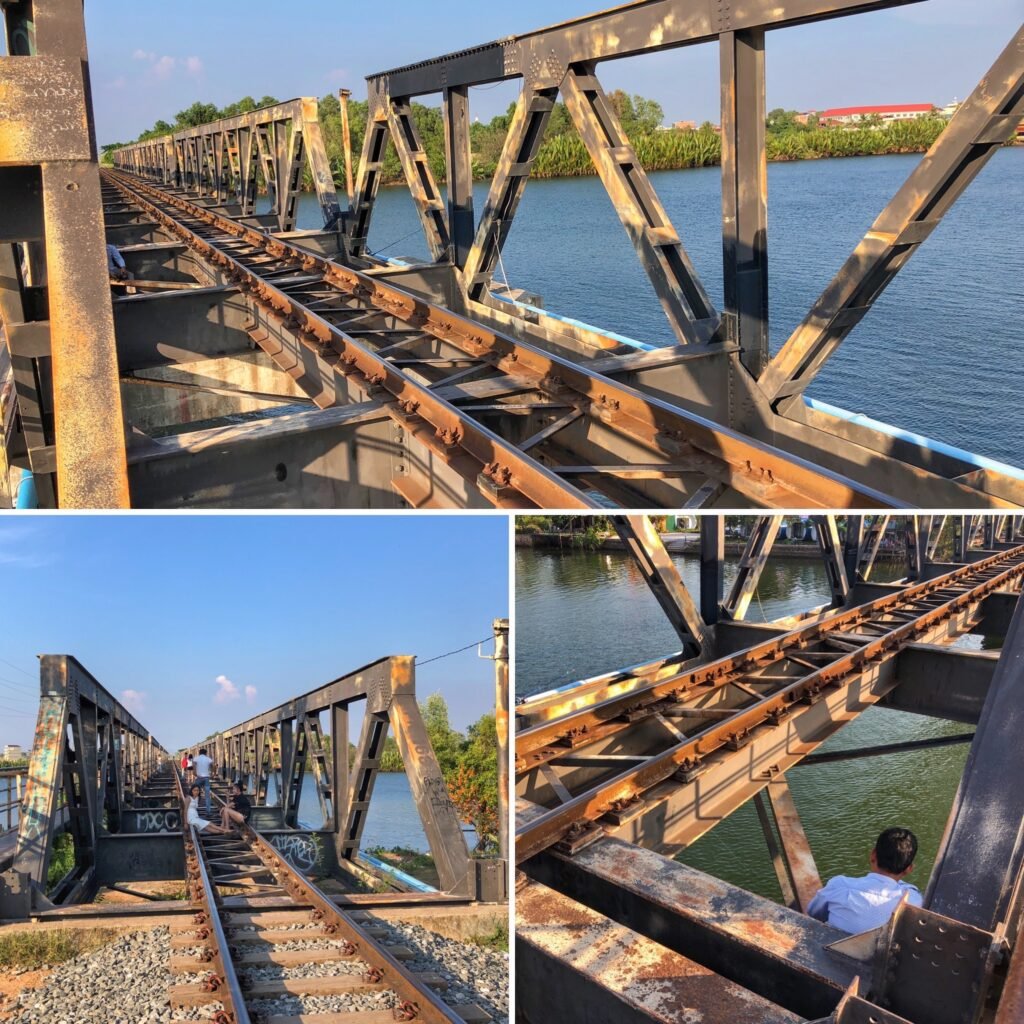
Walking to town later on (which took about 45 minutes), we decided to venture down the old railroad bridge where all the locals seemed to be gathered for Saturday night fun, or in one guy’s case, an evening catch hanging from the edge of the bridge. The worrying part is, we’d already seen two trains pass on this bridge. And once you’re on the tracks, there’s really no place to escape to quickly unless you’re jumping to the river below. Ah, but not to worry there was a pedestrian path on the side of the bridge. As we walked down the path, we couldn’t help soak in the amused glances we got from the locals as two white foreigners ambled down the tracks.
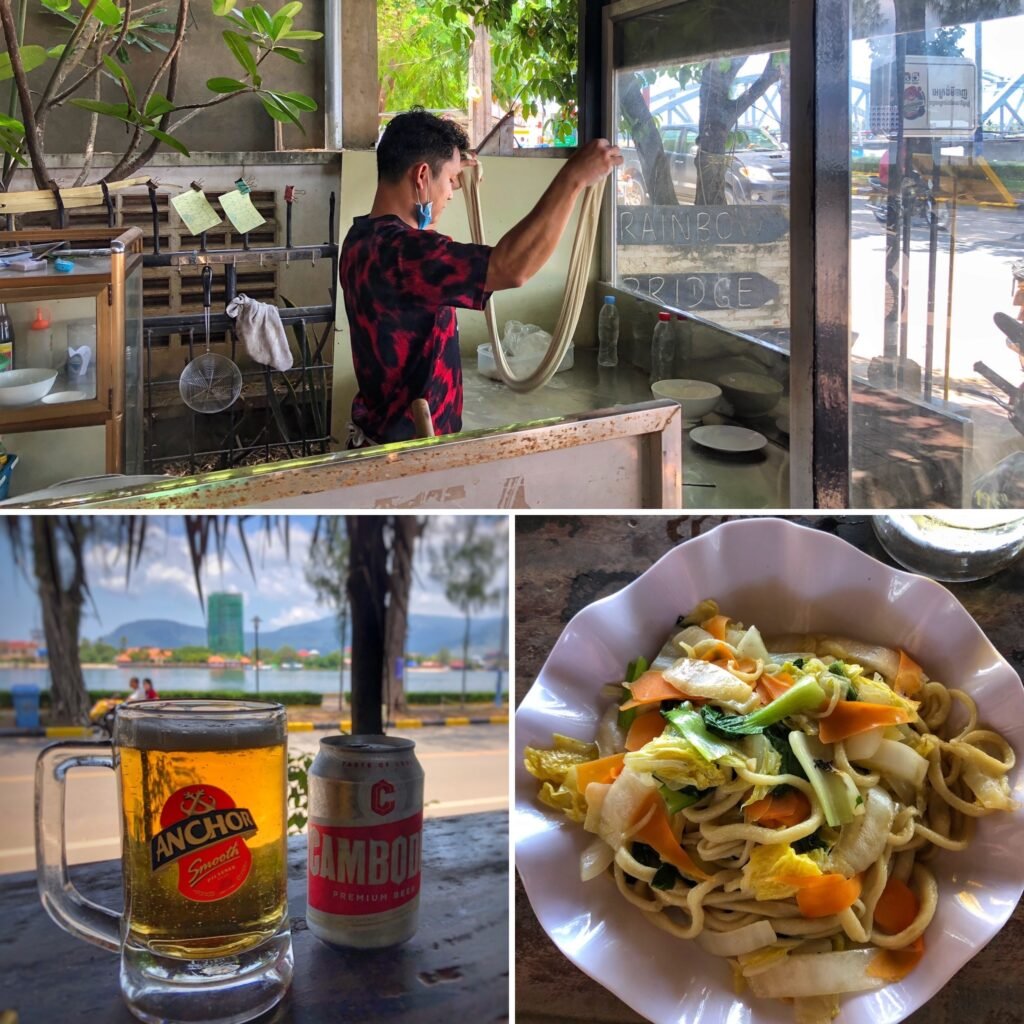
Heading giddily to Ecran Noodles to devour super tasty hand-made rolled Chinese noodles and dumplings for $2/plate.
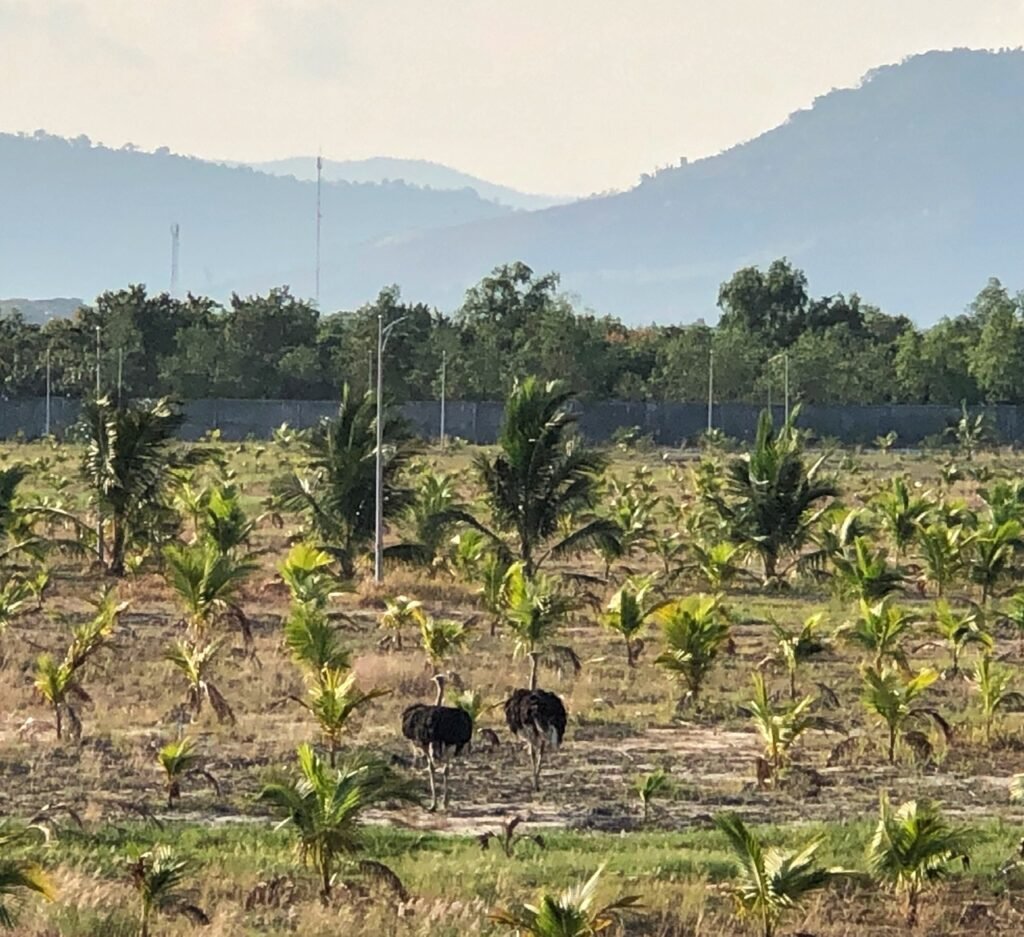
Oh, and don’t forget the cows we were looking at from a distant farm which slowly evolved into ostriches upon inching closer. For those that traveled with us in Tanzania, you might remember Mandy strongly dislikes this “monstrosity of a ‘bird.’” Fortunately, a concrete wall seemed to protect her.
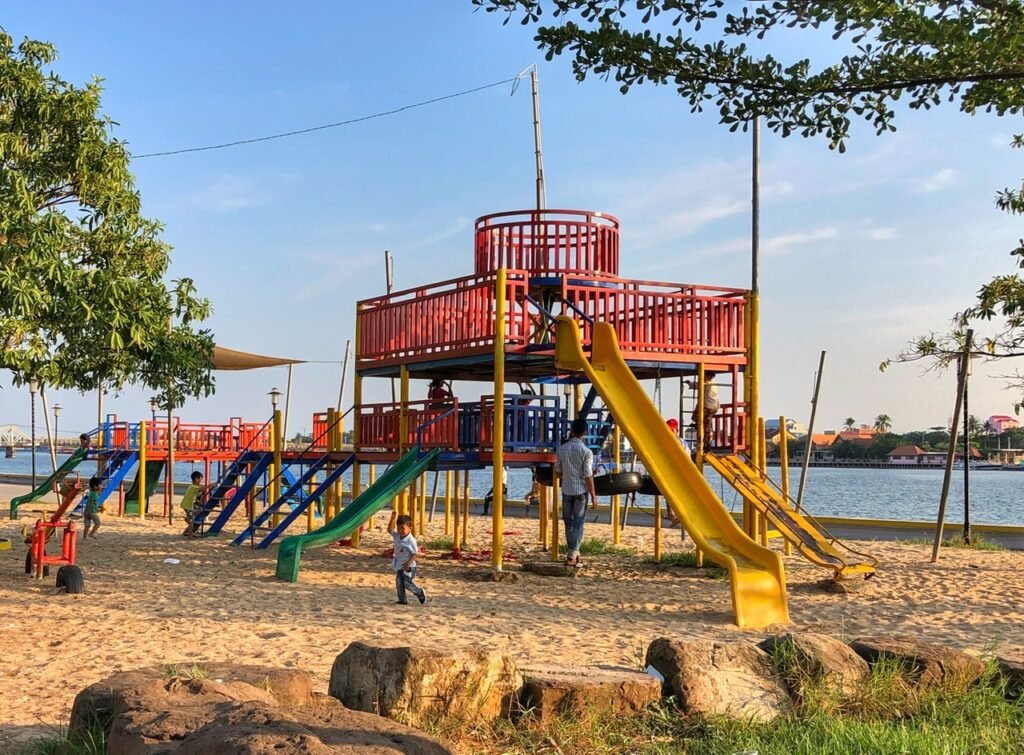
The playground along the river walk was filled with locals and expats alike. Kampot is one of the most expat-filled towns in Cambodia for good reason.

A traditional fruit mobile stand on a remork (Cambodian tuk tuk.) They typically fill the little cubbies with fruit slices, some of which are pickled and the have an assortment of sauces which a variety of condiments including spicy, vinegary, sugary and salty concoctions of all types.
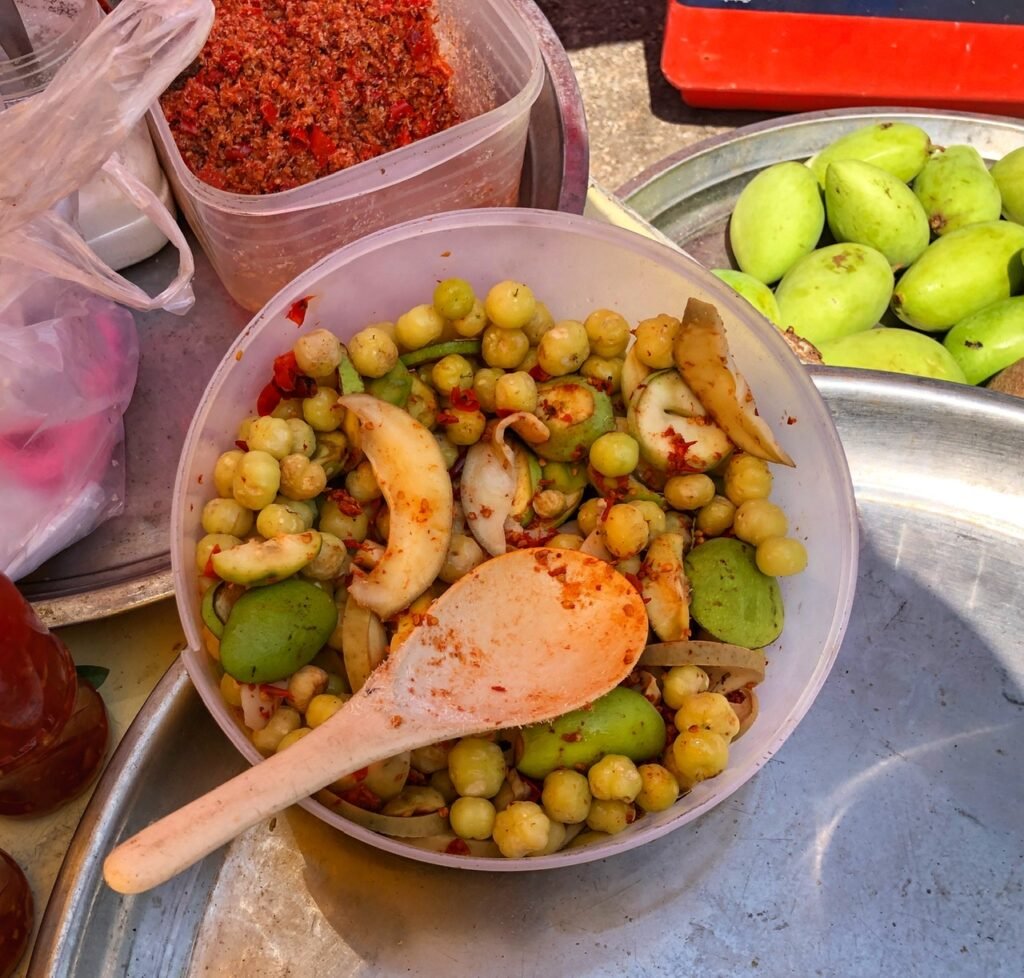
Mandy grabbed one that had “Cambodian grapes” according to the seller (it wasn’t…much more bitter…we think gooseberries) and guava, topped with spicy sugar. Not bad for $.25. But shoulda gone for the mango. Always go for the mango!

Oh yes, we’re in fruit heaven. In fact, there’s even a monument raised to the King of the Fruits…yes, durian proudly on displayed in the center traffic circle. (Side note: Kampot was a durian haven from the early 1940’s on. It reached it’s peak preeminence in the 1960’s, right before the Khmer Rouge crashed the party and durian orchards were burned in the areas considered suitable for rice growing, their wealthy owners murdered by the new anti-elite establishment. (yearofthedurian.com)

The charming French colonial streets of Kampot, some of it has been beautifully restored….
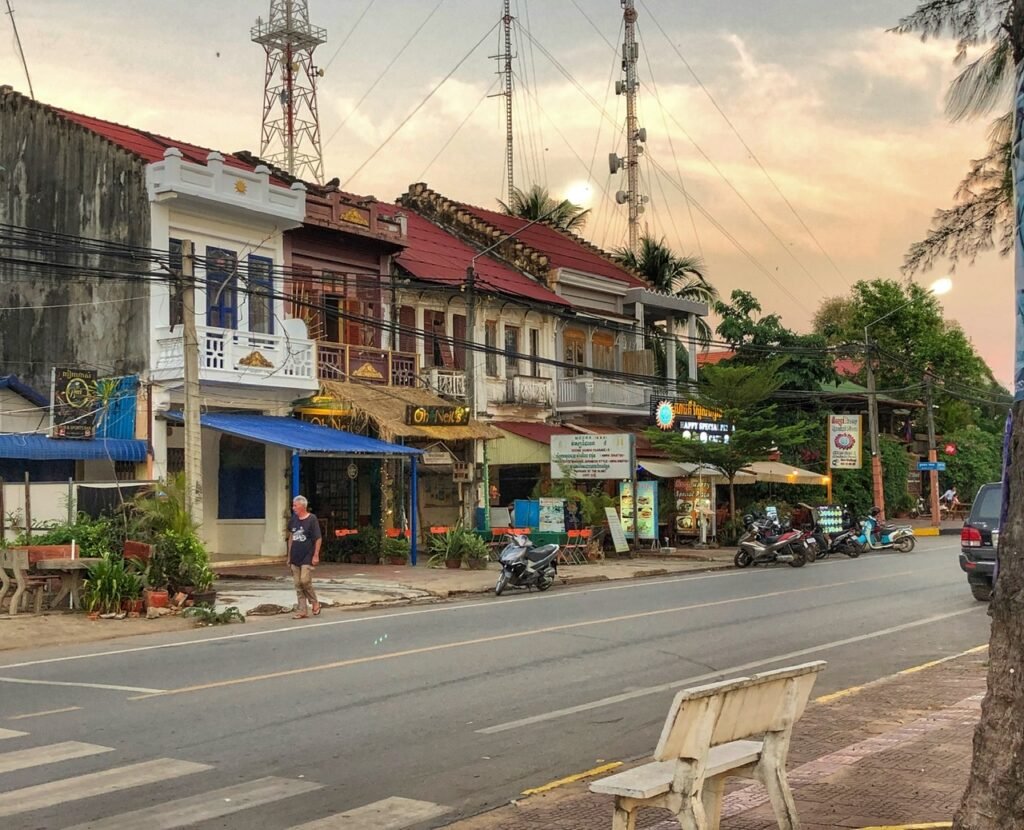
…and some awaiting their makeovers.

Another nice thing about being in Cambodia seems to be the access to splurging $5 on “Mexican.” Or at least as close as we’re gonna get it in Cambodia. Mmmm….Nachos….Mmm…cheese. That’s really all that matters…

The next day we rented a scooter for $5 from our hotel (normal, not COVID special price.) We headed to Bokor Mountain first because we had heard from a Tuk tuk driver the night before that it had reopened! While driving around we caught some glimpses of traditional ways… sometimes disturbing… like a poor chicken literally hanging from the back of a van, or later a LIVE chicken hanging off a motorbike between the rear wheel spikes and the exhaust pipe. It was very deeply disturbing. Why not kill the chicken first!?! ?

This is a typical gas station. Filling up cost $1.50.
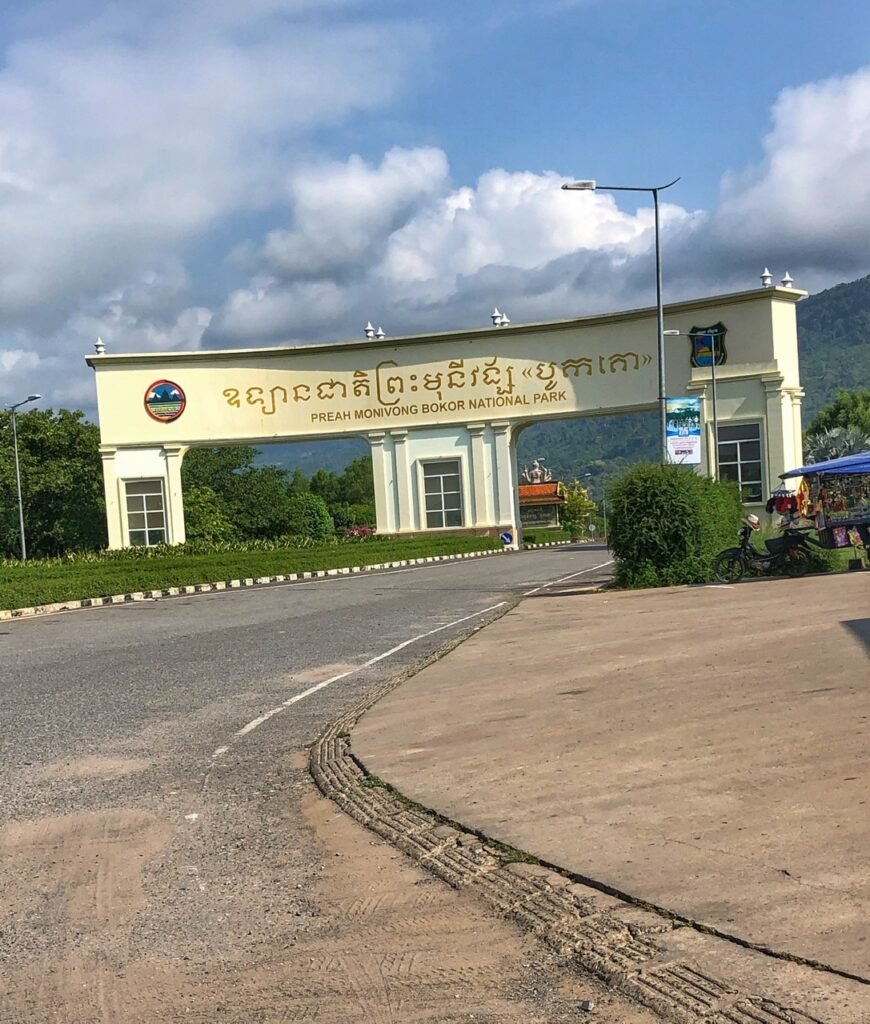
The entrance to Bokor Mountain National Park, one of the most beautiful parks in Cambodia, has a ridiculously extravagant entrance. No one was at the entrance booth to pay our $.50 entrance so we buzzed through.
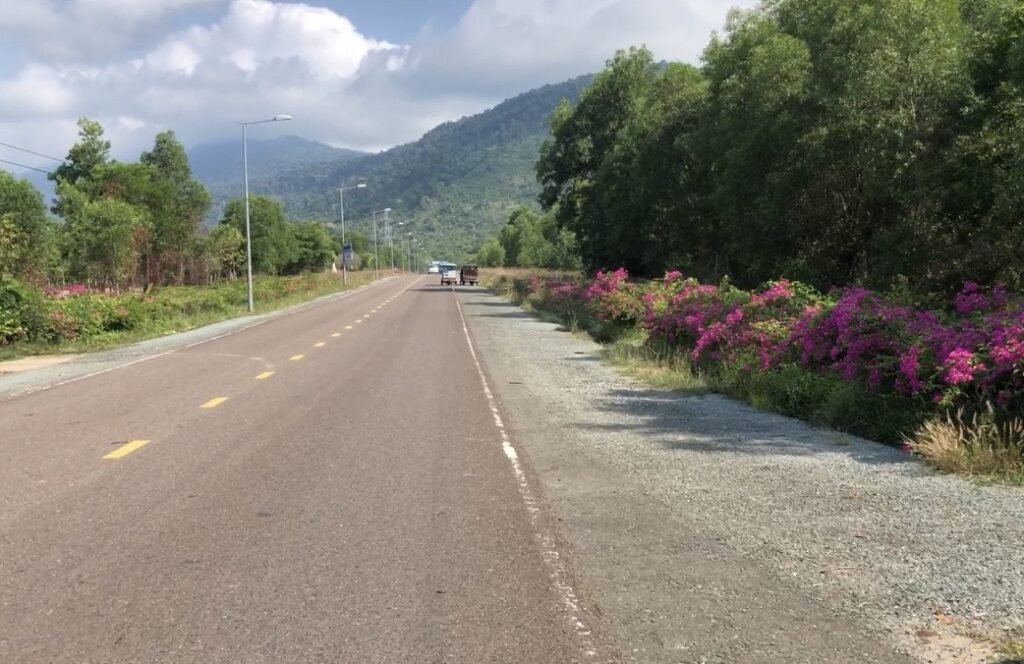
But shortly after we were stopped by a guard who turned us around. So why did we want to go up to Bokor Mountain so much? Well, atop it is Bokor Hill Station a former tourist resort from the 1920’s which is now an abandoned ghost town., as well as a stunning waterfall. Because of its elevation, it’s often socked in by fog, which sometimes gives it an eerie but beautiful look. Not to mention, there are stories of wild animals on the mountain, including tigers and elephants, but apparently more likely was giant birds or parrots, wild monkeys and some of the smaller large cats. Needless to say, we were bummed not to go.
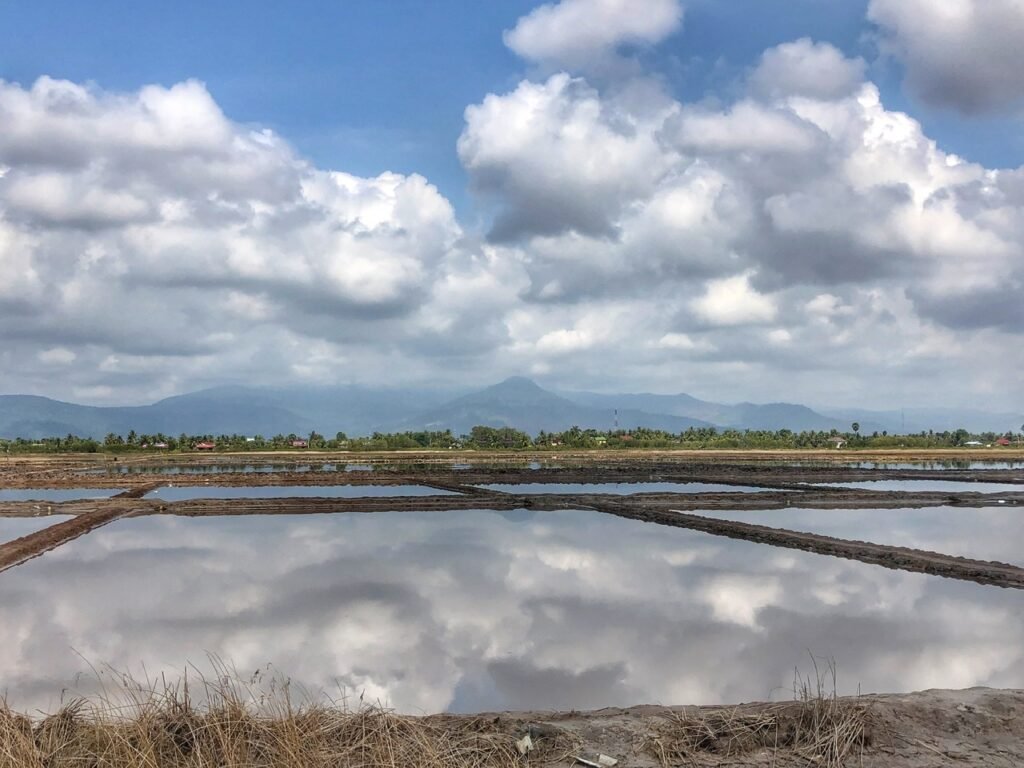
Instead we went off in search of Kampot’s two other pride and joys. The spice of life! The black king and white queen of every tabletop the world over. Salt and pepper, both produced in mass quantities in the salt pans and pepper plantations of rural southern Cambodia. Of course none of the salt nor pepper tourist facilities were open for us to take proper tours. So, we simply drove through the salt flats, which was really lovely thanks to the cloud’s reflections on the mirrored glass pools but not too exciting otherwise. Apparently the nearby seawater is routed into these salt evaporation ponds. As the water evaporates, salt crystals are left behind and harvested.
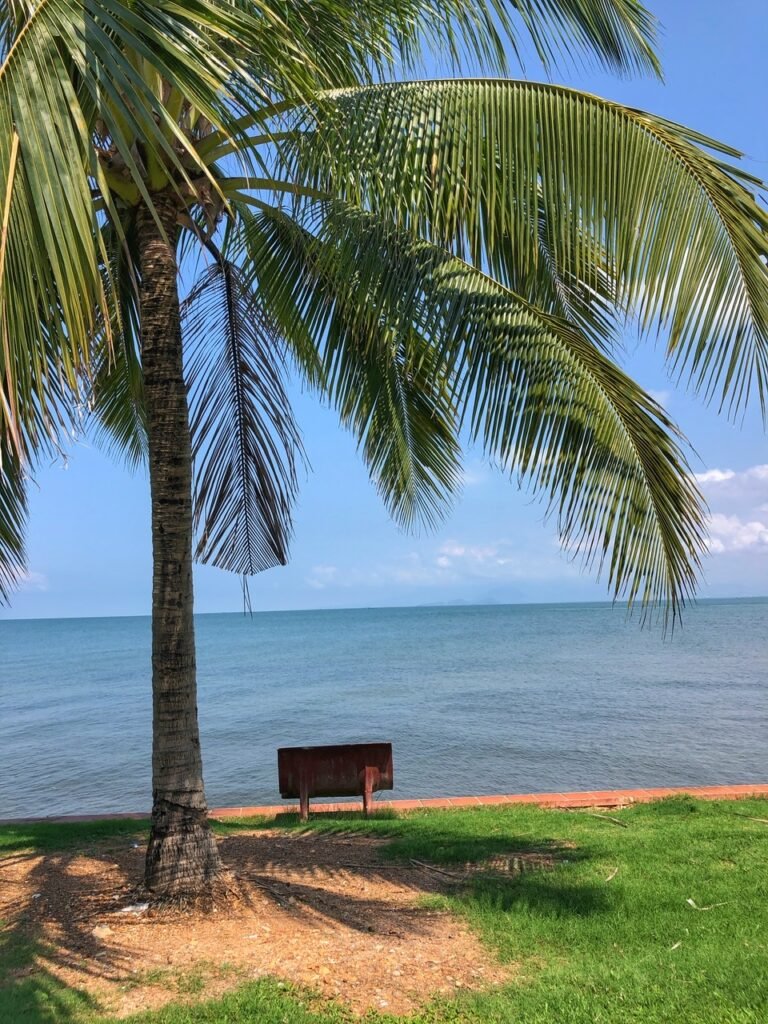
Continuing along our ride we were elated to finally reach the blue waters of the Gulf of Thailand again at the sleepy fishing town of Kep, which was founded as a seaside retreat for the French elite in 1908 and a favoured haunt of Cambodian high-rollers during the 1960s. It was so lovely to be at the seaside again after being away for months. Naturally we had to pull over to just sit on this bench a few minutes.
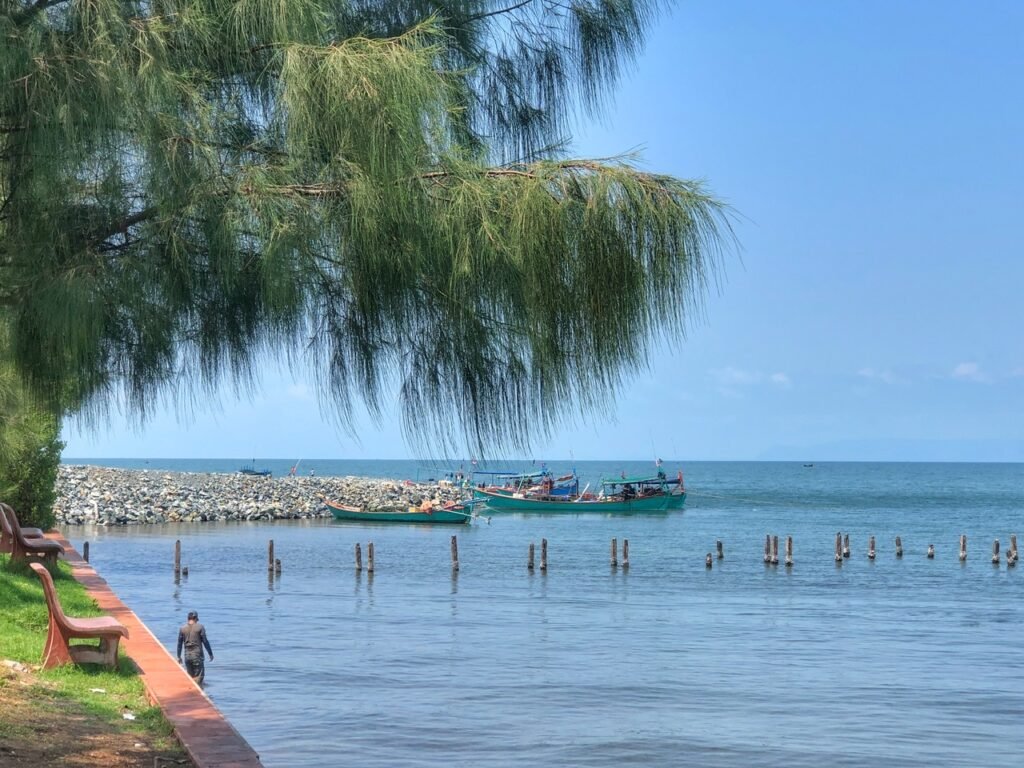
We observed and were awed by the locals free diving catching crabs in the shallow waters using only their hands and bamboo baskets. They incredibly didn’t even have masks or snorkels… likely catching these crabs the same way they had done for generations. Working long hours with opened eyes within the salty waters must be so difficult … wow…?
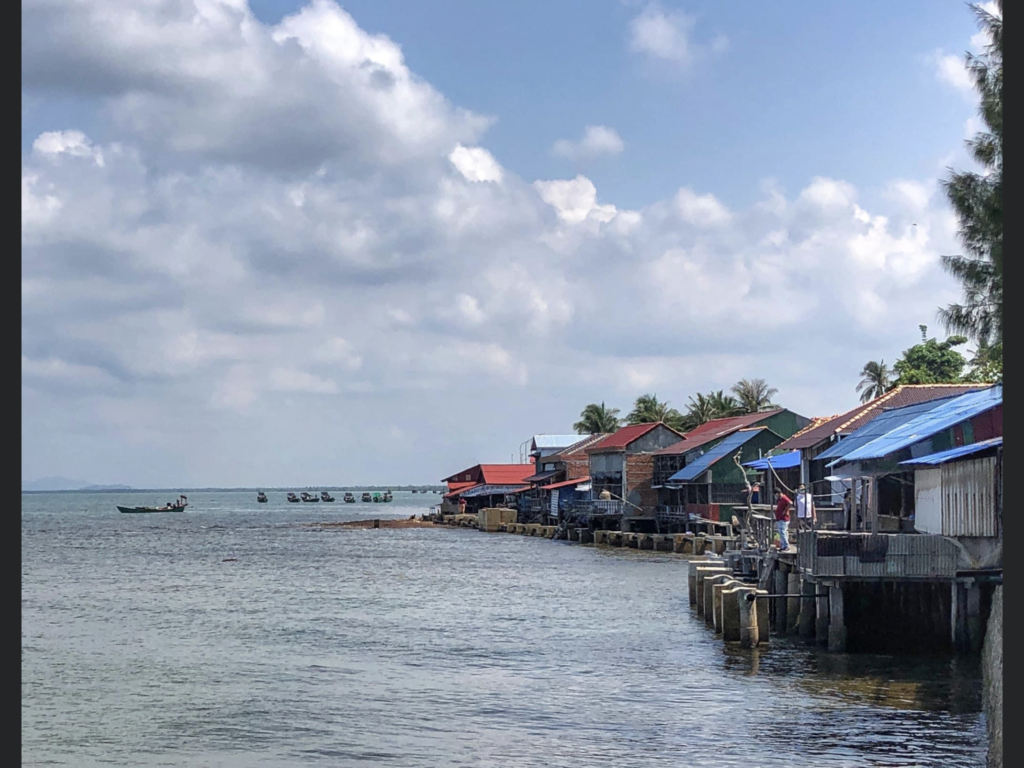
We continued onto the famous and very atmospheric Crab Market, Kep’s pride and joy, which is a row of wooden waterfront seafood restaurants situated next to a wet fresh fish market.
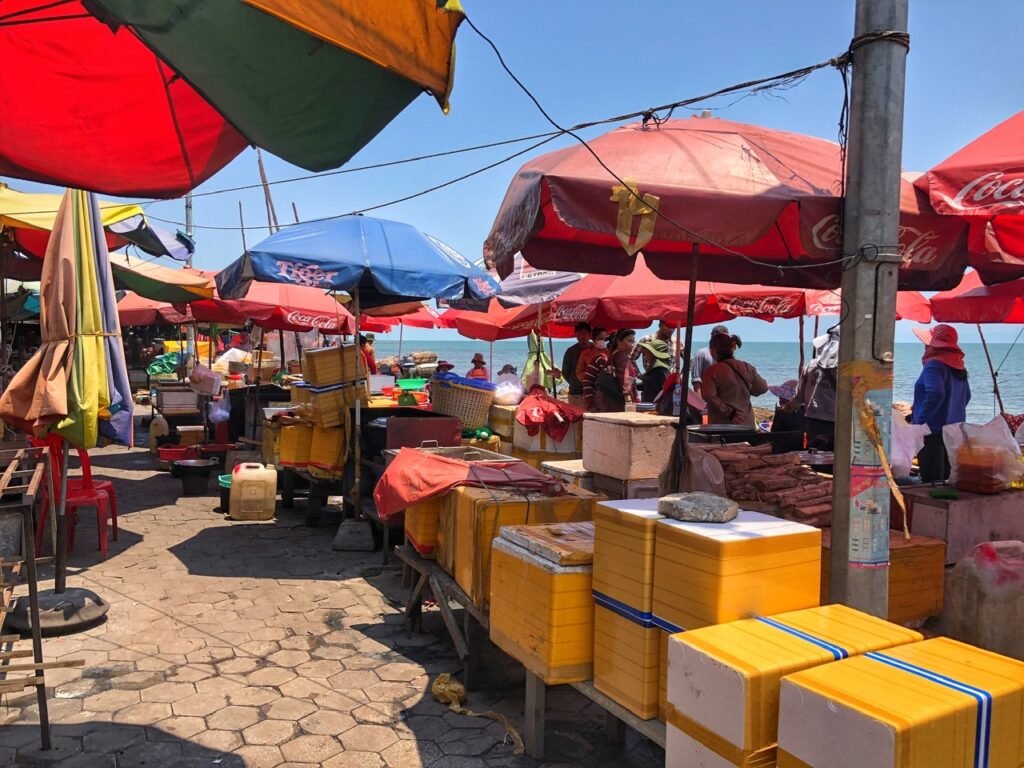
A very unusual market in that it was right on the waterfront, customers can literally negotiate prices on the crabs being pulled directly out of the surf behind. You can buy a kilo of crab here for as little as $1.25 and then have them boiled and served before you for an additional $.75. It was bustling with activity and color.
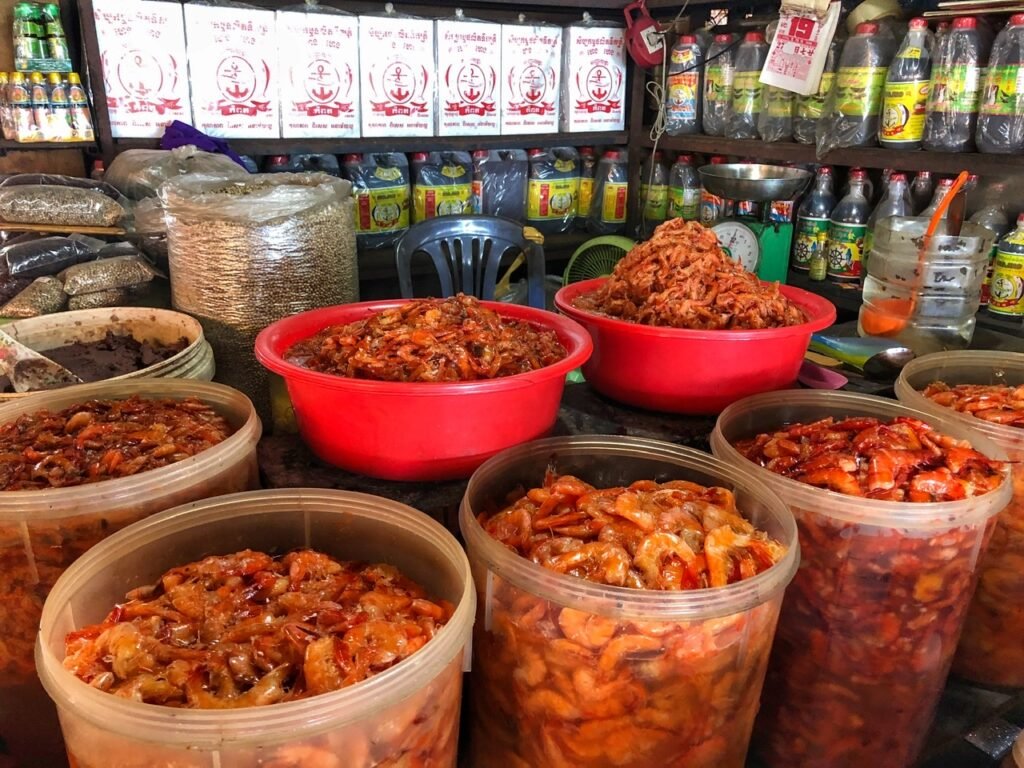
You can also buy a variety of marinated shrimp to take home.
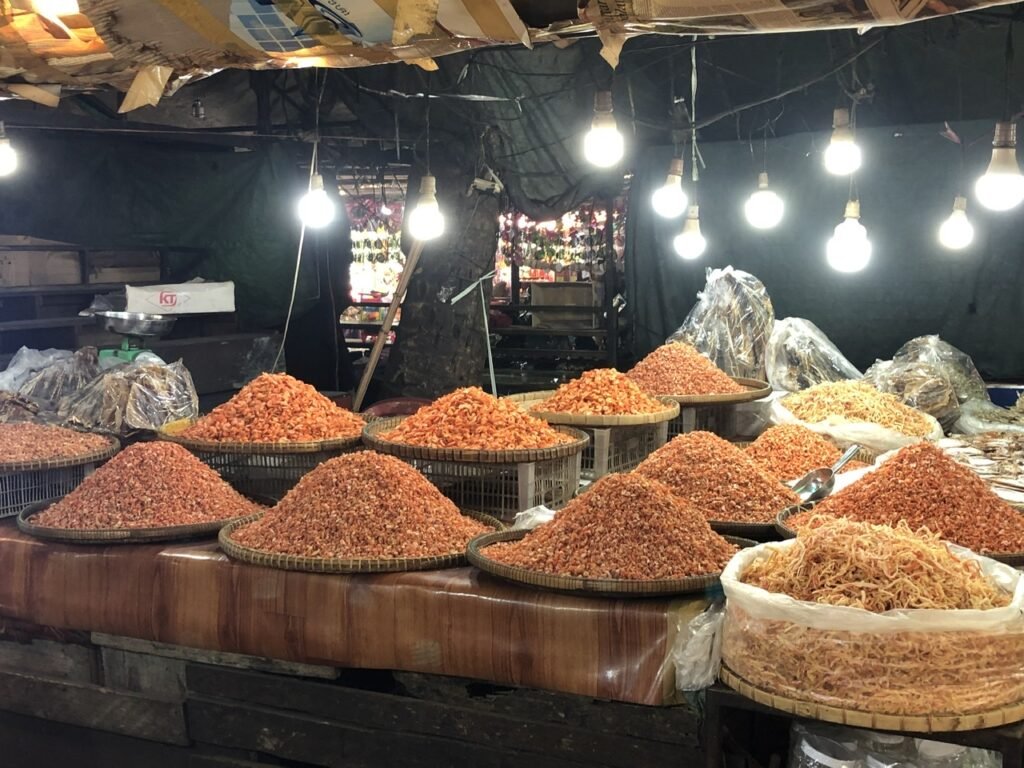
Or, dried varieties.

Or, a choice or grilled stick foods to suck in like a lollipop including octopi, squids or fish.
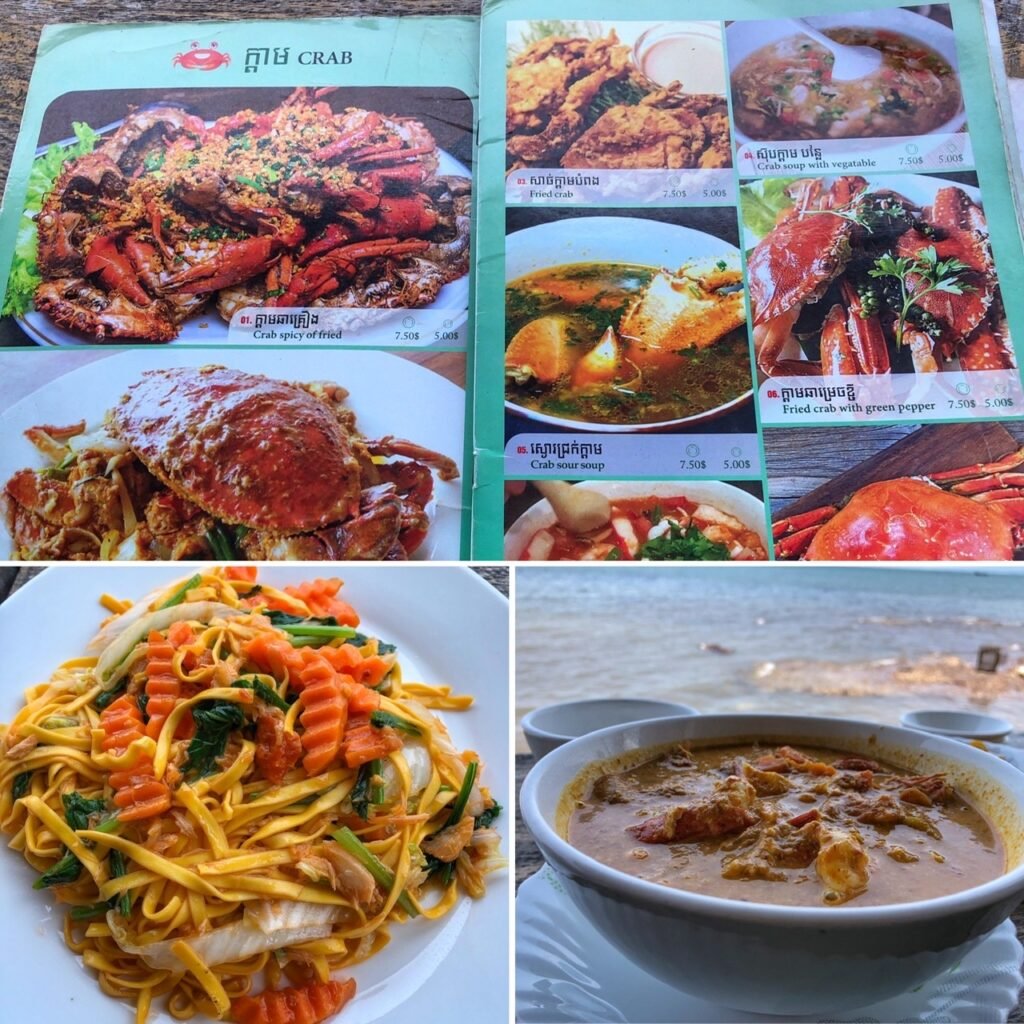
It seemed like there was no better place for us to take advantage of this amazing bounty of the sea so we splurged at one or the seaside restaurants by dropped a whopping $10 (with tip) on a massive bowl of shrimp curry with the biggest, fastest and juiciest shrimp we’ve ever had in our lives! And a plate of crab noodles, and a fresh pineapple shake. Check out the menu prices! It’s just insane what a gem this place was!
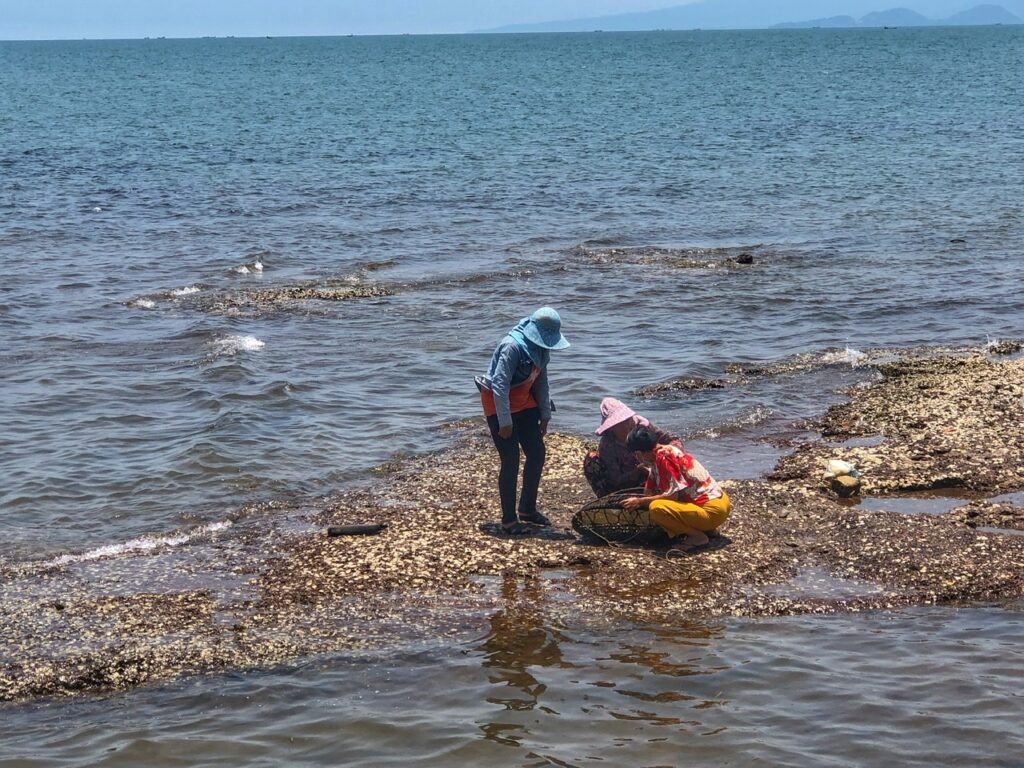
While we ate our shrimp overlooking the sea, we watched as the crab ladies collect the next guy’s meal from the old-fashioned bamboo traps. What a simple and beautiful process. Still…It reminded us of Sebastian on “The Little Mermaid” when he realized he is about to die. Not that he was a crab, but close enough.
We also learned later that there has been a lot of over-harvesting of the crabs in Kep for tourists. They used to be the size of dinner plates and now they are considerably smaller. This is not really part of tourism we wished to participate in, but we did it unknowingly.
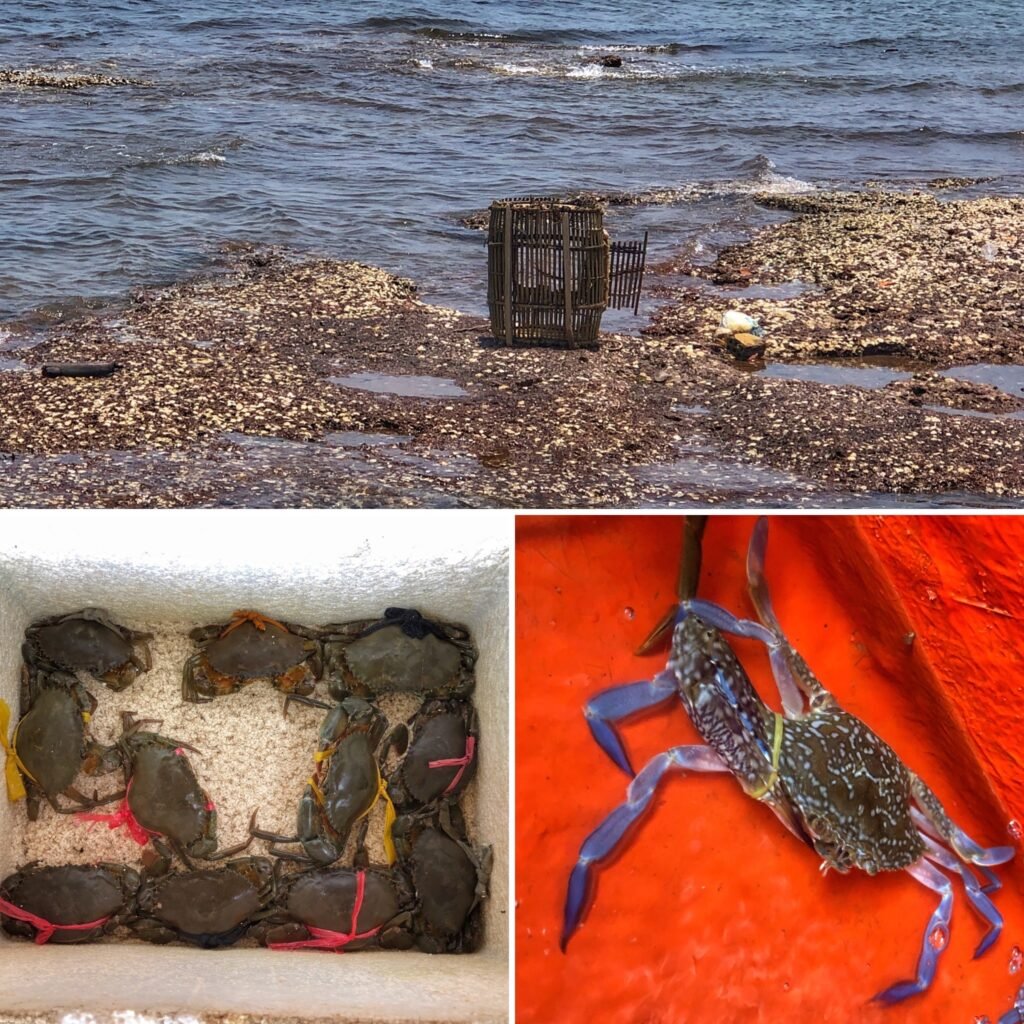
The crab trap, the ugly duckling crabs, and the beautiful swan crab all ready for consumption.
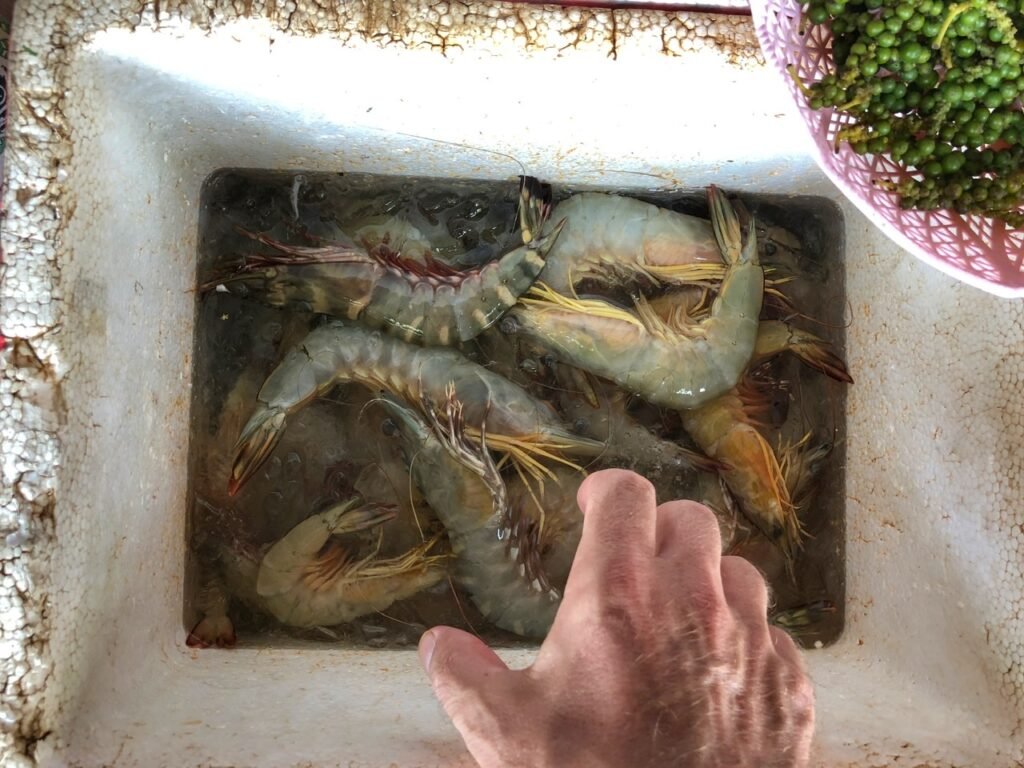
Oh, and the shrimp. At least 4-6” long and literally as big as Greg’s hand!!!
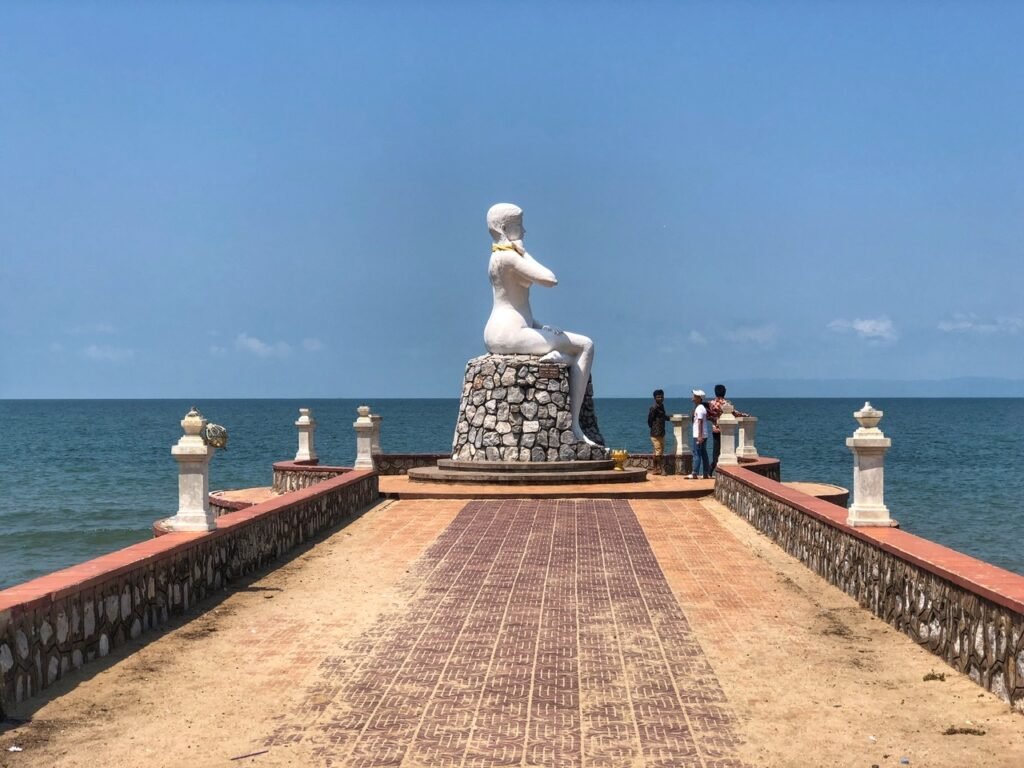
Visiting the White Lady Statue, which is exactly what it’s called. We read that it represents the story of lady who sat here waiting for her husband to fish along the sea. But her husband didn’t come back during a disaster so she decided to sit her waiting for her husband till she is died and became a statue. Now that’s devotion…
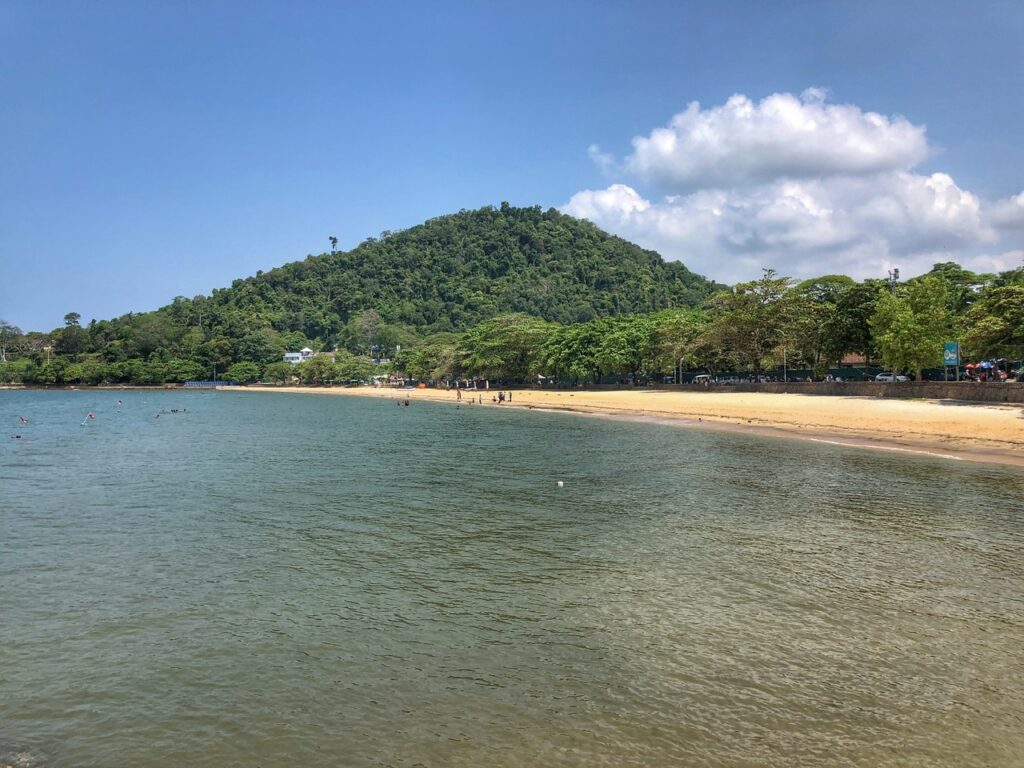
Kep Beach. From here we could sadly see nearby Phu Quoc island in Vietnam, which was supposed to be our first destination as we stepped our toe into the next country. We’ll get back eventually, but talk about look, but no touch.
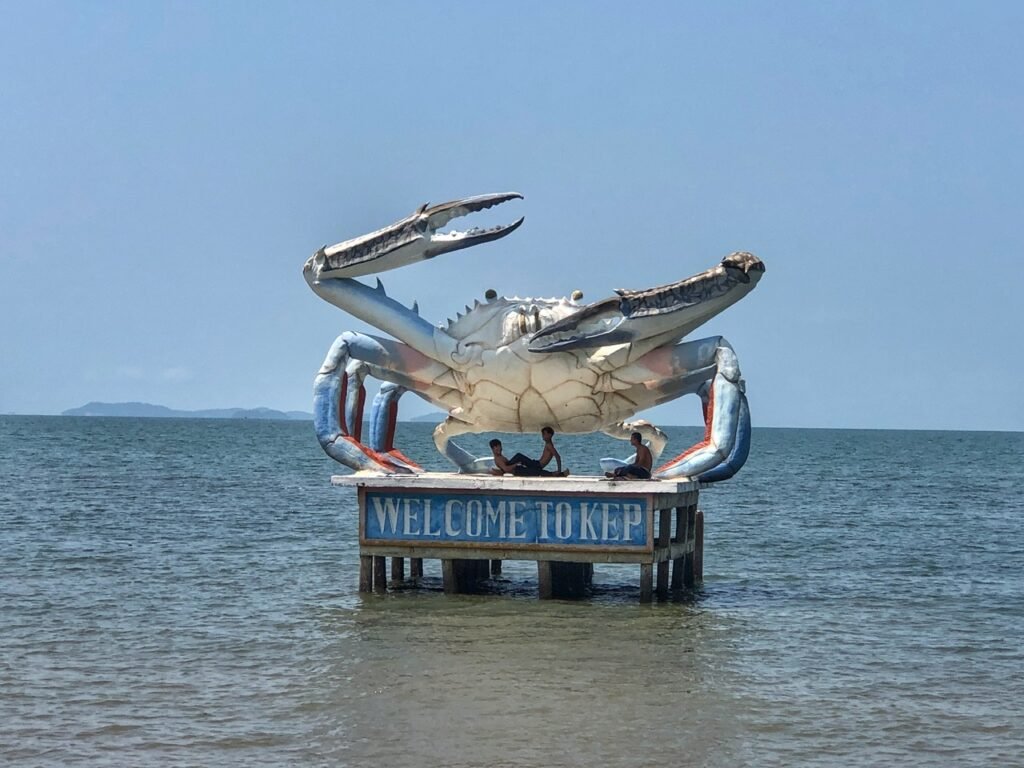
Just in case you forgot where you are. This is crab country. They’ve got pinchers and know how to use ‘em!
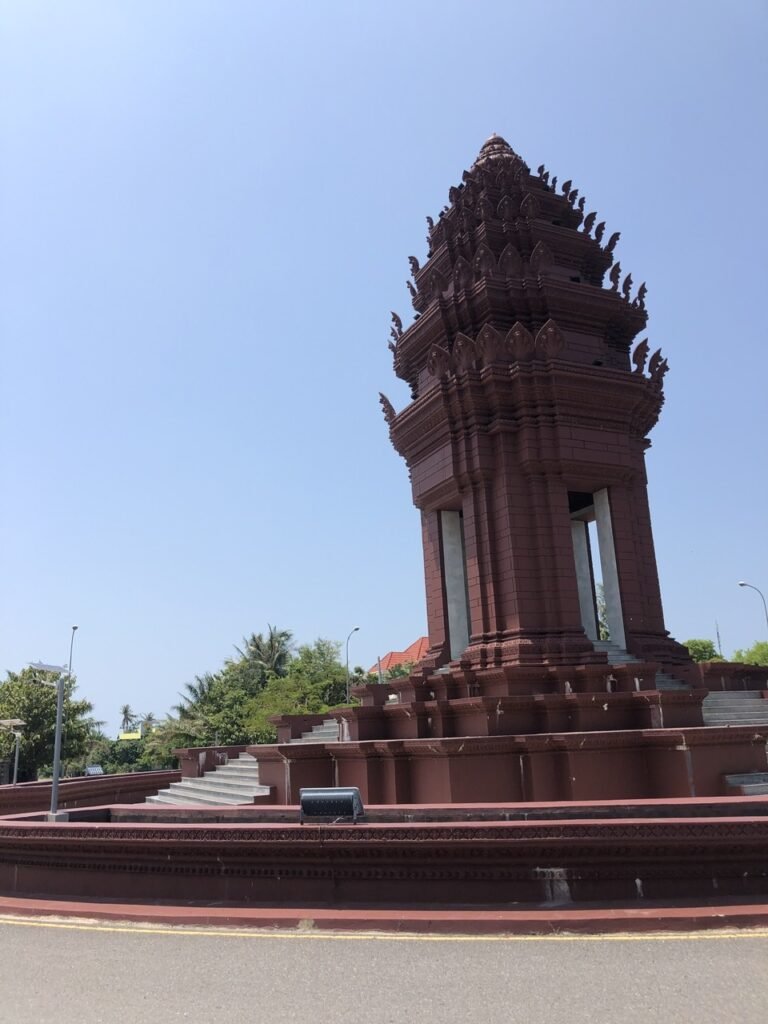
The Kep Independence monument. We’re noticing most towns in Cambodia seem to have one of these.
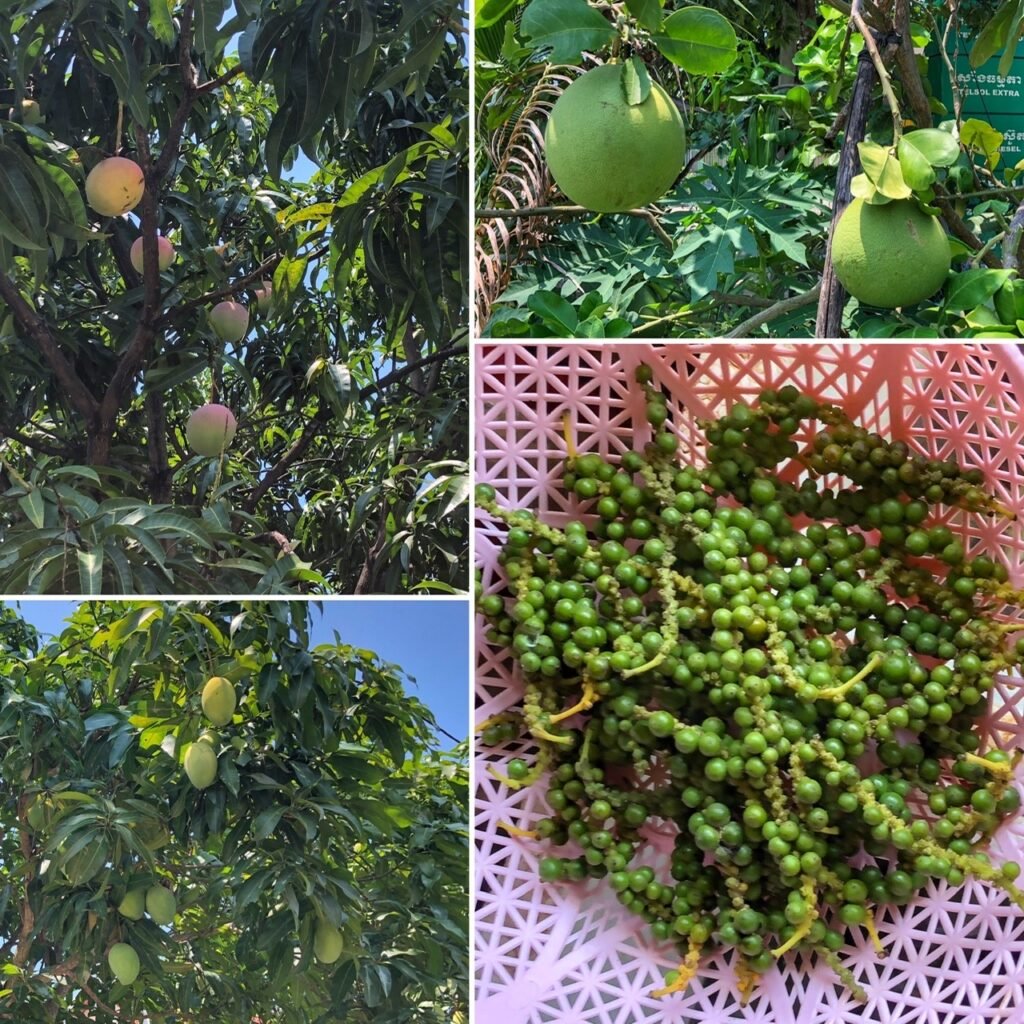
Because the pepper plantations were closed, we made sure to have a sampling of the notorious Kampot pepper…the little green beads. It was so delicious we bought some.
—-
We also had to find other things to entertain us so we drove around picking up fallen mangoes off of fruit trees. The streets were so loaded with them, because it’s also mango season here (!!) we probably saw five varieties and took home half a dozen. We were also tempted not to grab a pomelo from its home (top right.) These gargantuan citrus fruits are significantly larger than grapefruits, but for us, the official verdict on taste is yet to come.
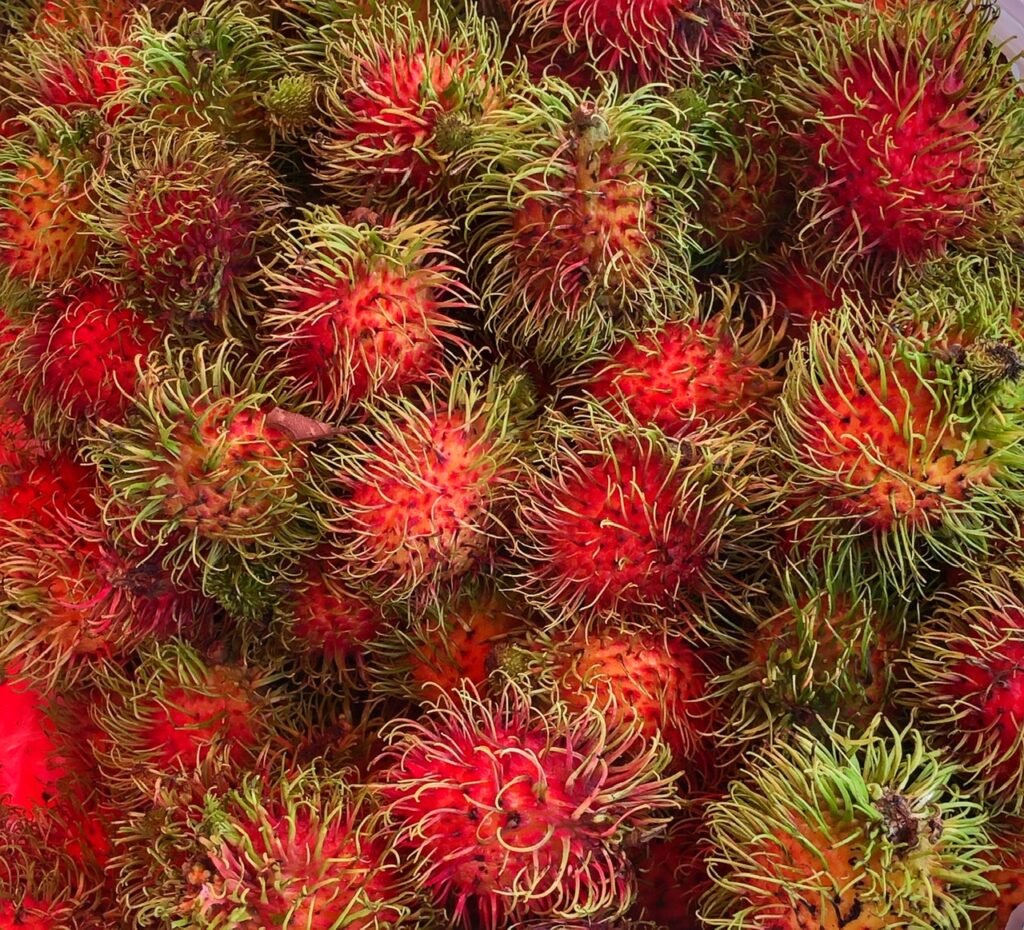
Another pleasure that we’re devouring lately is the little furry Rambutan fruit monster, now in season here! We’ll show you how to eat it later, but apparently it cures ailments like dry lips and mouth, prevents anemia, reduces bad cholesterol, prevents cancer, cleans kidneys, is an immunity booster, lowers blood pressure and rejuvenates skin. And thankfully this super fruit costs $1 or less a kilo!
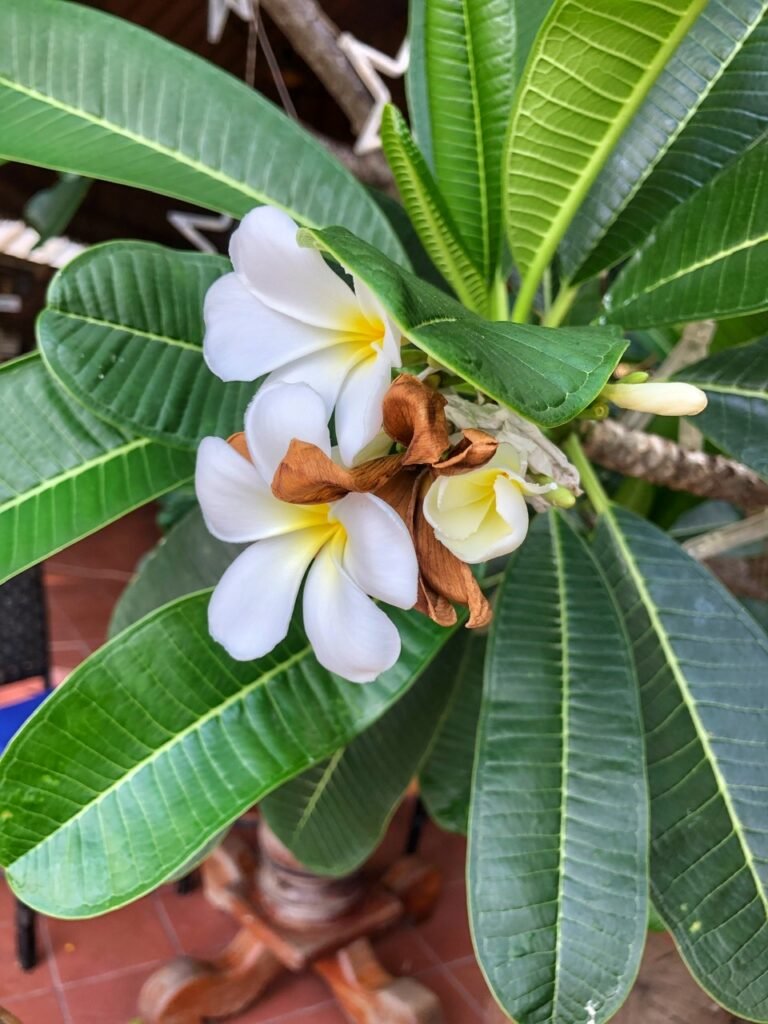
Plumeria, Mandy’s favorite tropical flower, is everywhere in Cambodia. Just love it.

